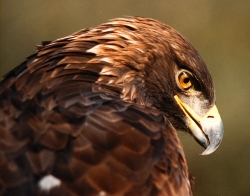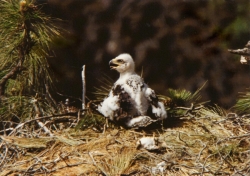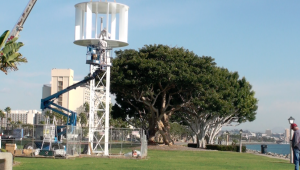“Wind farms are the main cause. The issuing of license to kill will accelerate the decline toward extinction.”—Save the Eagles International
An East County Magazine Special Report

By Miriam Raftery
January 6, 2012 (San Diego’s East County) – San Diego County’s 48 pairs of nesting golden eagles and even rarer bald eagles could be in peril if proposed industrial-scale wind farms are built. In a press release issued today, Save the Eagles International (STEI) issued a dire warning, providing detailed documentation proving that golden eagles and their nests are disappearing rapidly near wind farms across the U.S.
The group also blasted the U.S. Fish & Wildlife Service for changing its mission from protecting wildlife to “catering to the interests of an industry” that is a “ruinous one to boot.”
 Although the studies focused on golden eagles, if no major action is taken, wind turbines' razor-sharp blades will also threaten the existence of other species, STEI predicts.
Although the studies focused on golden eagles, if no major action is taken, wind turbines' razor-sharp blades will also threaten the existence of other species, STEI predicts.
The international group "solemnly warns the Western States that the biologically-blind policies will cause the extinction of the Golden Eagle, the California Condor, and other species of raptors.” Also at risk are species in Eastern and Central states, such as the Whooping Crane.
The evidence
This week, wildlife biologist Jim Wiegand, Vice President of SEI, examined park records and found that at least half of the golden eagles nests (5 of 10) in the vicinity of the Altamont Pass wind farm in northern California have disappeared since 2005. (Eagles mate for life and return to the same nest year after year. Wiegand provided detailed maps of former and current locations as evidence.)
 But the devastation is far worse—and could quadruple in the near future. At Altamont alone, 116 golden eagles have been reported killed by the turbine blades each year. That’s 2,900 dead golden eagles over the wind farm’s 25 year history.
But the devastation is far worse—and could quadruple in the near future. At Altamont alone, 116 golden eagles have been reported killed by the turbine blades each year. That’s 2,900 dead golden eagles over the wind farm’s 25 year history.
Now, regulators have approved reducing old turbines at Altamont with fewer but larger turbines that have bigger blade sweeps—doubling the power output in a move that “could be killing four times as many golden eagles as with the old turbines,” according to SEI.
New turbines such as those planned for East County tower hundreds of feet tall with blade spans as large as many jetliners—far larger than the existing turbines on tribal lands. Some are planned on National Forest and Bureau of Land Management lands that until a few years ago were protected as wilderness, but were opened up for energy development by the Bush administration, a step the Obama administration has not reversed but instead, used as an opportunity to fast-track numerous large-scale wind and solar projects in an effort to reduce greenhouse gas emissions and global warming.
 But are projects that slaughter wildlife really green?
But are projects that slaughter wildlife really green?
Altamont isn’t the only wind project killing eagles. Federal authorities are investigating deaths of at least six golden eagles at the Los Angeles Department of Water and Power’s Pine Tree Wind Project in the Tehachapi Mountains, the U.S. Fish and Wildlife Service reported in August. Numerous eagle kills are also reported in Colorado and Wyoming.
HawkWatch International, another nonprofit organization concerned with bird mortalities, predicts that the Chokeberry and Sierra Madre wind project in Wyoming will slaughter 700 birds of prey a year, including more than 200 golden eagles, the Casper Star Tribune in Wyoming reported on November 28, 2011.
Bats have also had populations decimated by wind farms. Even more ominously, scientific studies reported in New Scientist found that bats died in large numbers even when they didn’t strike the blades at wind farms. The bats died of internal hemorrhaging and lungs that literally exploded. The gruesome finding is believed to be due to changes in air pressure caused by the massive spinning blades.
View videos and still photos of large birds and bats striking wind turbines: http://savetheeaglesinternational.org/?page_id=131
Federal watchdogs or industry lap dogs?
 Officially, windmills kill a half million birds a year in the U.S., according to the U.S. Fish and Wildlife Service. There are currently 500 wind farms a year in the U.S., the Washington Post reported in August 2011. But many more are planned.
Officially, windmills kill a half million birds a year in the U.S., according to the U.S. Fish and Wildlife Service. There are currently 500 wind farms a year in the U.S., the Washington Post reported in August 2011. But many more are planned.
But Trish Sweanor, a U.S. Fish and Wildlife Service biologist, admitted, "We really don't know how many birds are being killed by wind turbines," according to the Casper Star Tribune.
That hasn’t stopped the federal agency from instituting a new policy issuing “take permits” that actually give wind farm operators permission to kill a limited number of eagles in Oregon and Washington for example. Save the Eagles denounced this practice as a “perversion, which has illegally but effectively changed the mission of FWS from preserving biodiversity to that of catering to the interests of an industry, an ineffective and ruinous one to boot.”
The federal agency has largely relied on industry representatives to count the bodies of beheaded and eviscerated birds beneath the giant blades. But avian experts contend that wind farms hide the carnage, burying bodies or carting them off in the dead of night. A citizens’ public records request for raptor kills on a wind farm on tribal-owned land was allegedly denied on privacy grounds.
The wind industry defends its actions
 Wind industry supporters have tried to diminish concerns.
Wind industry supporters have tried to diminish concerns.
“The reality is that everything we do as human beings has an impact on the natural environment,” said John Anderson, director of siting policy for the wind-energy association the Washington Post reported recently.
Wind industry advocates note that bird kills from wind farms counted thus far are lower than total bird kills from flying into glass windows or being hit by cars, and roughly equal to the number killed by cats.
But those perils predominantly kill smaller songbirds; an eagle is more apt to carry off a housecat than the other way around—and soaring eagles nesting in rugged terrain are far more likely to fly into a wind turbine than a household window. Counts of bird kills for smaller species are tougher to conduct, moreover, since a fallen songbird may be carried off or eaten by small animals.

San Diego Supervisors to weigh wind ordinance that could fast-track projects
In San Diego, where Supervisors are now considering a wind ordinance that would make it easier to build large-scale wind farms in East County, today's news is particularly relevant. It comes on the heels of last week's announcement by the U.S. Department of the Interior that the Department had approved the Tule Wind Farm for McCain Valley in East County, though additional approvals are needed for the full project. Many other projects are planned nearby, including a massive project in Ocotillo in neighboring Imperial County.
That has some local residents deeply concerned. Charles and Laurie Baker of Santee, who regularly hike areas near the proposed Tule Wind Farm and others, submitted photos of eagles in flight and apparently nesting.
 "We observe and have pictures of many large birds of prey in the McCain Valley area soaring above ridgetops," they wrote, including photos as proof. "We think the Tule wind turbine project and other proposed wind turbine projects would present a hazsard for electrocution or collision with fan blades for golden eagles and should not be built." She further asked, "Do we know if there would be a ripple effect on animal populations they hunt for food if their [raptors] numbers decline?"
"We observe and have pictures of many large birds of prey in the McCain Valley area soaring above ridgetops," they wrote, including photos as proof. "We think the Tule wind turbine project and other proposed wind turbine projects would present a hazsard for electrocution or collision with fan blades for golden eagles and should not be built." She further asked, "Do we know if there would be a ripple effect on animal populations they hunt for food if their [raptors] numbers decline?"
The Bakers noted that SDG&E, in an environmental impact report on Energia Juarez high voltage transmission lines argued, ironically, that high voltage towers provided nesting space for eagles in areas including McCain Valley. But the Bakers observed, "However, the Audobon Society wrote a letter stating the opposite is true...Birds that nest on the Sunrise Powerlink towers could collide with the rotating blades of the wind turbines when hunting for food."
Eagle experts call for action to halt wind farm destruction of birds
Wildlife experts, meanwhile, believe it's time for the state and federal government to take action to halt the massive proliferation of wind farms as evidence mounts of their dangers to wildlife, including threatened and endangered species.
“The Altamont Pass wind farm should have been closed down and decommissioned a long time ago,” STEI said of the most infamous eagle-killing facility. “But pork-barrel politics have kept it in operation,” a release signed by STEI president Mark Duchamp as well as Vice President Jim Wiegand, STEI United States.
Both have also expressed grave fears for San Diego County's eagles and other raptors if the wind farms proposed here are allowed to be built.
“No amount of bad science financed by the wind industry and government agencies have been able to convince honest conservationists that wind farms don’t harm bird and bat populations,” Save The Eagles International concludes.
Are there alternatives?
 In a word, yes.
In a word, yes.
Long-term, vertical axis wind turbines hold promise. To date, only small-scale models have been developed--including one recently installed as a pilot program by the San Diego Port District. "Many of these turbines have been installed throughout Japan and because of their unique vertical structure, there have been no reported problems, like the ones that occur with horizontal axis turbines, such as injuries to bird populations, according to Nakao Consulting and Enterprises," the Port District's website states.
Wiegand at Save the Eagles confirmed that vertical axis turbines "absolutely" can be viable alternatives and if research dollars are invested "will be far superior to the propeller turbine." But he told ECM, "They haven't been developed due to corruption and greed. All the tooling and production are set up for the bird-killer style."
Here are links to several other vertical axis designs:
Maglev Wind Turbine http://www.youtube.com/watch?v=Y7Qs2gFlt-o&feature=related
The Energy Ball http://www.home-energy.com/engels/ebv100technical.htm http://www.youtube.com/watch?v=IA-tJ2oPwgc
Enepro design http://www.youtube.com/watch?v=7TspdI4Sd1o&feature=related
DS400 http://www.youtube.com/watch?v=9PNngA4wP9o&feature=endscreen&NR=1
Vertical Axis Wind Turbine DS1500 in Active http://www.youtube.com/watch?v=CkIX3_O8sWg&feature=related
Aerospiral Operating at 9m/s (by Aerowind Systems) http://www.youtube.com/watch?v=PMGrnpEuDhY&feature=related
 For now, however, the most promising clean energy alternative for the San Diego region is sunshine. Prominent environmental designer Jim Bell has estimated that our region could meet its energy needs entirely through rooftop solar, including solar on buildings as well as shade structures over parking garages. Large-scale desert solar projects could also produce significant power, though they face their own set of environmental issues.
For now, however, the most promising clean energy alternative for the San Diego region is sunshine. Prominent environmental designer Jim Bell has estimated that our region could meet its energy needs entirely through rooftop solar, including solar on buildings as well as shade structures over parking garages. Large-scale desert solar projects could also produce significant power, though they face their own set of environmental issues.
Rooftop solar also lacks the serious negative impacts of other options, such as carbon-producing fossil fuels or nuclear, which has come under growing scrutiny in earthquake-prone California falling the Fukushima, Japan earthquake and ensuing nuclear meltdown.
But rooftop solar has no profit motive for utility companies such as SDG&E, that are under state mandate to increase clean energy production. Recently, in fact, SDG&E has been lobbying to impose a fee on homeowners or business owners who want to produce their own solar power. Contrast that scenario to places like Germany, which fast-tracked its ramp-up to clean energy by providing incentives for conversion to solar power across the nation.

The fate of our national bird?
Will the eagle, America's national symbol, survive the onslaught posed by spinning turbines across the continent? That remains to be seen--and the future of eagles in the U.S. may hinge on whether federal and state regulators take action to enforce laws against killing eagles.
If an individual kills an eagle, it's a felony punishable by steep fines and jail time. But thus far, not a single wind energy executive has been jailed or even prosecuted despite thousands of unauthorized eagle deaths.
When the founding fathers chose the eagle, Benjamin Franklin dissented--suggesting that the wild turkey be named our national bird instead.
Perhaps Franklin's choice was prophetic, since the wild turkeys in our region have one distinct advantage over eagles: turkeys can't fly high enough to be slaughtered by wind turbines' fast-whirling blades.







Comments
Wind industry disclosures have ALWAYS avoided Tip Speed
It is now known that the early Altamont and Tehachapi wind turbines were mass killers of bird and bats. The industry hid this for years and is still hiding the majority of fatalities at all wind farms. Despite what you read or hear from the industry, the new large turbines are NOT SAFER for birds. They are far more dangerous. With the old smaller turbines, their blades turned faster at72-80 rpm, but the tip speed for these blades was only about 125 mph (184 ft sec). The tip speed was far lower because the blades were only 22 ft long. The new huge turbines have blades 150 ft long or more and when spinning at 20 RPM, have a blade tips moving at 314 ft per second or 214 mph.
The blades of the turbines with lower rpm not only fool the public but also fool birds and eagles more easily. This is because they can see right through these huge illusive openings between the blades and think they can fly through them to what they see on the other side. The industry has fraudulently capitalized on this illusion in the media. The new turbines are also more dangerous for another reason. These turbines spend more time rotating throughout the year. They are made with lower cut in speeds, so they start turning at lower wind speeds. This means that each turbine is more lethal to birds and bats because they spend more time with their blade tips ripping through the air.
It is easy for anyone to figure out tip speed once you know the blade length, diameter, and maximum rpm. Here is the math for the so called new generation safer wind turbines. They generally spin at 16-20 rpm 1) A single blade on a 300-400 foot turbine with 150 foot blades slowly moving at 20 rotations per minute will equal a circle with a 300 foot diameter. At 20 rotations each blade tip is moving 20 x 300 x 3.14 feet per minute =18840 feet per minute divided by 60 which equals 314 ft per sec or 214 miles per hour.
Better Science
I am making a comment in reference to the earlier comment about better science. I could not agree more but I would like to ad that we also desperately need ethics. Problems can never be solved if the experts are creating bogus studies and deliberately designing(rigging) their methodology for a desired goal. I see this routinely with the wind industry.
As for the “noble cause” about greenhouse gas reduction goals, which corporate America conveniently considers to be a much larger threat to bird and all other species – Let’s put the climate change blame exactly where it really belongs – Deforestation. Micro climates are being changed daily all over the world from industry. The deforestation problem is now being made even worse from the installation of wind farms and accompanying infrastructure. Anyone that wants to see this can just take a ride on Google earth over to New England and look a the mess.
In ten to twenty years time down the road, after hundreds of thousands of square miles of precious ecosystem habitat have been chewed up and raptor populations all over the world are crashing – What will wind energy have accomplished? At best 20% of the energy needs and we will still the have the oil consumption problem, the deforestation problem and climate change.
The entire wind industry know very well that there is no way to ever make the propeller style wind turbine safe for birds and bats. That is why they built an industry with virtually no regulations or accountability. This way the truth could be hidden. I really believe if the public were to ever see the true suffering to eagles and other birds caused by this industry we would not have to be having this discussion. The images of eagles and other birds with body parts missing then wandering around for days before dying would change this industry. According to a California Energy Commission report, the most common injury to a raptor hit by a wind turbine is, a severed wing. These eagles and other raptors mate for life and were meant to live 20-35 years. Not any more. A nest that was being watched by a photographer saw a female golden eagle lose her mate four years in a row before the nest was abandoned. This nest was located near Altamont pass.
Now readers have a better idea why I despise this industry. When I see a wind turbine, I see a tombstone for an eagle because I know what happens at wind farms. I also know for a fact mortality is far worse than what is being reported. As far as I am concerned, until I stop seeing bogus wind industry studies and start seeing the aggressive development of new turbine designs, this industry can never be considered a solution of any kind.
We need better science before we proceed
As a member Golden Gate Audubon Society, and as a Californian who has fought unacceptable wind development here and elsewhere, I echo that wind farms create a threat to our wildlife. Human built environment (our roads, buildings, houses, and industrial infrastructure) is one of the greatest killers of birds in the US, and wind farms (including the Altamont Pass Wind Farm) are especially dangerous to raptors like hawks and eagles, as well as to bats.
Golden Gate Audubon has sued the local authorities and the wind industry to try to stop the unnecessary slaughter of birds here at Altamont Pass. After many years of court actions and negotiations, we have finally succeeded in reaching an agreement that the area will be "repowered", in which smaller, lower, and more numerous generators will be replaced by larger, taller, and fewer modern turbines. The best estimates are that this will reduce the kill of raptors by 70% or more. We have agreed to this settlement because we believe that given the history of the site, this is the best outcome we can expect for wildlife, and we hope and expect that it will show that wind development is compatible with healthy raptor populations. However, no one who has followed this controversy over the last 30 years would say that the Altamont project was well reviewed when it was first proposed, and if we could somehow start from scratch, every environmentalist would have demanded much better science before any permitting or construction began.
I welcome coverage of this important topic by the East County Magazine, and suggest that your reporters contact other experts in the field for further insight into the issue, and how it affects East County San Diego. If wind projects are authorized in the area with inadequate science and unknown impacts, the local loss of iconic species like the Golden Eagle is a distinct possibility.
Alan Harper
Oakland, CA